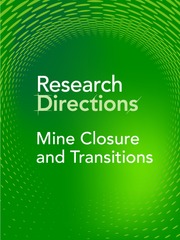Context
Traditionally understood in technical, environmental and (to a lesser extent) socio-economic terms, mine closure and transition is increasingly recognized as a significant governance challenge. Governance, in this context, refers not merely to the legal aspects of mine reclamation or closure regulation but rather the broader suite of actors, institutions, processes, methods, rules and practices that guide and oversee mine site transitions. Governance structures, interactions and practices are shaped by power relations as well as reflecting embedded norms and values. Since the 1980s, mine closure governance has expanded from a preoccupation by industry and governments with hazard mitigation, environmental reclamation and, in some cases, economic and social ‘adjustment,’ to encompass a wider set of social, economic and environmental aspects of closure (Kendall Reference Kendall, Neil, Tykkalainen and Bradbury1992; Laurence Reference Laurence2006). These issues may affect workers, local and regional development agencies, Indigenous rightsholders, fenceline communities and environmental advocates, among others (Bainton and Holcombe Reference Bainton and Holcombe2018; Everingham et al. Reference Everingham, Svobodova, Mackenzie and Witt2020). This broad range of actors and issues, in turn, has generated reactions and responses from individual companies, industry associations and governments at all levels seeking to mitigate closure and transition impacts (Morrison-Saunders et al. Reference Morrison-Saunders, McHenry, Rita Sequeira, Gorey, Mtegha and Doepel2016; Owen and Kemp Reference Owen and Kemp2018; Hodge and Brehaut Reference Hodge and Brehaut2023).
Meeting the challenges of mine site transition requires new forms of interaction and governance processes, some of which may be incorporated into formal requirements (such as impact assessment, regulatory compliance or negotiated agreements) (Kabir Reference Kabir2021; Getty and Morrison-Saunders Reference Getty and Morrison-Saunders2020), and others which remain in the realm of semi-formal and site-specific processes (such as industry standards, community/stakeholder engagement, regional planning initiatives or even co-governance arrangements) (Monosky and Keeling Reference Monosky and Keeling2021a; ICMM 2019; Xavier et al. Reference Xavier, Veiga and Zyl2015; MAC 2008). The timelines and mechanisms surrounding closure governance also present confounding factors, including the long-term impacts of social dislocation and questions of adequately funding and managing long-term liabilities associated with environmental reclamation (Mills Reference Mills2022; Aghakazemjourabbaf and Insley Reference Aghakazemjourabbaf and Insley2021; Keenan and Holcombe Reference Keenan and Holcombe2021).
In the end, the success or failure of closure governance has implications not only for the communities and landscapes planning for or experiencing closure but also for the wider question of mining’s social acceptability and the industry’s claims to foster “sustainable development.” For local Indigenous communities, inheritors of post-mining landscapes, closure governance intersects with broader questions of Indigenous land rights, self-determination, and social and economic reclamation (Hall and Pryce Reference Hall and Pryce2023; Hall and Ascough Reference Hall and Ascough2023; Boulot and Collins Reference Boulot and Collins2023; O’Faircheallaigh and Lawrence Reference O’Faircheallaigh and Lawrence2019; Monosky and Keeling Reference Monosky and Keeling2021b; Beckett and Keeling Reference Beckett and Keeling2019; Barnes et al. Reference Barnes, Holcombe and Parmenter2020; Cohen Reference Cohen2017). Yet, this stage of a mine’s life presents financial and resource constraints as production rates decline, meaning there may be unfulfilled socio-economic development expectations and increased complexity around legacy issues.
Despite a recent surge in research interest relating to mine closure governance, many questions remain about how to optimize mine closure to ensure just and sustainable closure and reclamation outcomes. Addressing these challenges requires attention to the vast differences in regulatory, social and economic contexts across the global industry. This geographical diversity resists easy generalization of examples or prescriptions for “best practices” for mine closure governance. Nevertheless, there is much to learn from past and ongoing examples of mine closure and reclamation activities to inform governance arrangements now and in the future. In this spirit, we are inviting the submission of case studies, tools and analysis from any relevant mine closure context that addresses aspects of the central question above, as well as submissions providing insight into governance challenges and processes more generally. The following are some relevant themes and questions to consider:
-
What are the most important or effective governance mechanisms (voluntary or regulatory; formal or informal) for mine closure and transition?
-
What are the key challenges in engaging stakeholders/rightsholders in closure governance?
-
What are the main risks associated with the failure of governance and engagement around closure?
-
How should closure governance processes adapt and change over the life of the mine and beyond the transition phase?
-
What are some notable success stories/cautionary tales of mine closure and transition planning and governance?
How to contribute to this question
If you believe you can contribute to answering this question with your research outputs, find out how to submit in the Instructions for authors. This journal publishes results, analyses, impact papers and additional content such as preprints and “grey literature”. Questions will be closed when the editors agree that enough has been published to answer the question so before submitting, check if this is still an active question. If it is closed, another relevant question may be currently open, so do review all the open questions in your field. For any further queries check the information pages or contact this email mines@cambridge.org.
Competing interests
None.






